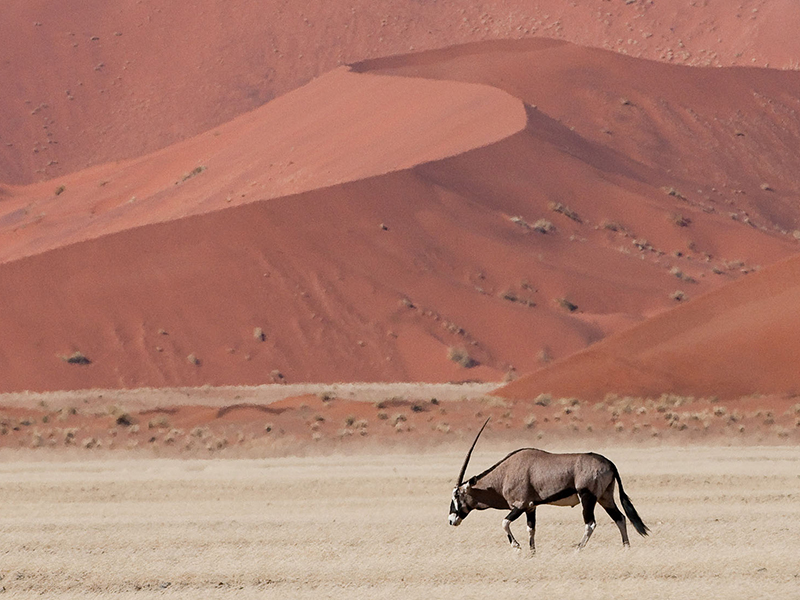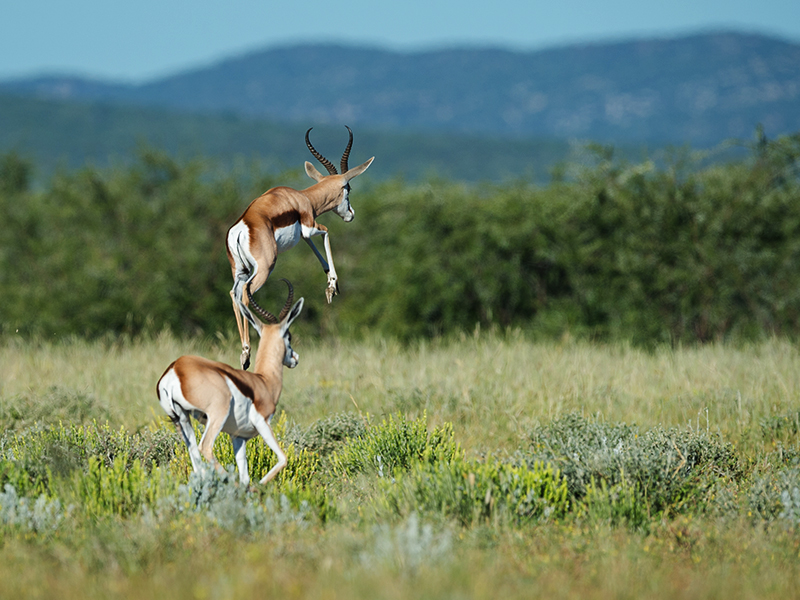About Namibia
Namibia is a vast and beautiful country, located on the west coast of Southern Africa. Most famous for its towering sand dunes that run straight into the sea, Namibia is a sparsely populated country with many secret wonders. Its landscape varies from the vast dry deserts of the Kalahari, to canyons (second in size only to the Grand Canyon), to wide open grasslands seemingly taken straight from a National Geographic documentary.
Namibia is a country where the wildlife still have a place to call their own; uninhibited, unfenced, untouched and free. Visitors to this area are just silent spectators of the natural beauty that has been manifesting for thousands of years – a photographer’s dream and an adventurer’s aim, Namibia’s rugged beauty is what keeps people coming back to learn more.
Because Namibia is so vast and sparsely populated, it’s best to have a set plan when visiting, as well as a decent sized wallet. Getting around the country is difficult alone, and best done as a fly-in safari. However, for the more intrepid travellers, seeing the country by road is most spectacular.
Top Destinations in Namibia
- Etosha National Park: A true wildlife destination with a massive salt pan so large you can see it from space.
- Namib-Naukluft National Park: This park is home to incredible landscape, unique only to Namibia, with some of the tallest sand dunes in the world.
- Swakopmund: This is a vibrant coastal holiday town with many different attractions and activities.
- Fish River Canyon: The world’s second largest canyon after the Grand Canyon.
- Skeleton Coast: Where sand meets sea. A historic, unique and (at times) eerie place where skeletons of boats and sea creatures alike are laid to rest.
Points of Interest
Etosha National Park:
Although Namibia is not a top wildlife destination as a whole, Etosha National Park, located in the northern part of the country, is one of Africa’s best game reserves. The Etosha Pan, also known as the ‘Land of Dry Water’, is roughly the size of Holland and the majority of its landscape is made up of seemingly endless white sand. In the dry season, when most of the water in the area has evaporated, the few remaining water pans are thriving with game and four of the Big Five can be spotted: Lion, Leopard, Elephant, and Rhino.
Surrounding the Etosha Pan are areas of Mopane woodlands where over 340 species of birds can be spotted. The Etosha Pan is ideal for self-driving travellers, as it has well-maintained roads and signposts for ease of navigation. The best time to visit this area would be between May – October, but be prepared for more crowds and higher prices than other times of the year as this is peak tourist season.
Namib-Naukluft National Park:
Covering nearly 50,000 square kilometers of Namibia’s southwestern region, Namib-Naukluft NP is one of the largest conservation areas in Africa. The Sossusvlei area is one of Namibia’s most recognisable landscapes, with its ocean of red sand being constantly manipulated and shifted by the change of the winds like waves on the sea. Although it is not a primary wildlife destination, spotting and observing some of the desert-adapted animals can be quite remarkable. In particular, a herd of Oryx meandering through the red dunes at sunset is a scene you won’t soon forget. The best time to visit is between April-May or September, when the weather is more pleasant – avoid the hottest months where the temperatures can reach 40 degress.
Swakopmund:
For a break from the rugged wilderness of Namibia’s national parks, Swakopmund is an excellent place to unwind and enjoy a bit of culture. Rich in German history, this coastal town has many great restaurants and hotels with many different attractions and activities. With options for the adrenaline junkie (from dune-bike riding to free-fall parachuting) or for a more cultured excursion for the more intellectually inclined (museums, galleries, and libraries), this vibrant town has something to offer for everyone.
Fish River Canyon:
Fish River Canyon is the southern hemisphere’s largest canyon and the second largest on the planet, right behind the Grand Canyon. The Fish River Canyon, which extends for 160 kilometers in Namibia’s southernmost corner, is an excellent place for hiking and scenic viewing. Its width reaches 27kms long and an impressive 550m from top to bottom, but its vastness can only truly be grasped in person. This location is great for self-driving clients, as flying can be quite expensive to this area.
Skeleton Coast:
Spread along Namibia’s northern coastline, the Skeleton Coast is a graveyard for large sea vessels whose Captains met their match in the rough Atlantic currents along Africa’s western shores. It is a curious and strange place, which must be visited to experience its odd yet tragic beauty. This area is also home to Cape fur seal colonies, one of the most interesting creatures to sit and observe as these curious and playful animals go about their daily routine.
Travel information
There are limited direct flights to Namibia, so it is best to book your international flight to O.R. Tambo in Johannesburg and catch a smaller commercial flight to Windhoek. Getting to your onward destination can either be by small aircraft or vehicle. The roads in Namibia are well maintained, so it is a great and safe place for a self-drive safari.
Visa Requirements:
- Entry permits can change so best to contact your local Namibian Embassy before travelling.
- Passports must be valid for at least 6 months.
- All visitors must carry their onward or return airline ticket.
- Citizens from most countries staying less than 30 days do not require a visa and will receive an entry permit upon arrival.
Currency:
- The Namibian Dollar is the official currency of the country and is fixed to equal the rate of the South African Rand. Both the Namibian Dollar and the Rand are accepted freely throughout the country.
- Credit Card facilities are common in the country, but there are places where these aren’t accepted, so please be prepared to pay cash for some items.
Tipping:
As in most parts of the world, tipping is completely up to a guest’s discretion and whether or not you were satisfied with the service provided.
- Who?
- Your guides and staff at a safari lodge.
- When?
- Amount?
- Guides: roughly N$/ZAR 50 per guest for half-day activities, double for full-day excursions.
- Lodge Staff: N$/ZAR 40 per guest per day.
Seasonal Information
With its mild climate Namibia can be visited throughout the year; it has a very short rainy season between December and March, and even then the rain is sporadic. Like many other parts of southern Africa, wildlife viewing is best done during the dry season.
January – April: Wet season (Summer)
During this period there is a light rainfall (compared to surrounding countries), which can become heavier in January and February. Although sporadic at best, the rainfall decreases during the months of March and April. Even with the short-lived rains, midsummer temperatures can reach an average high of 30-35 deg C and can exceed 40 degrees in the desert.
May – October: Dry Season (Winter)
Although this is Namibia’s winter period, there is little-to-no rain during this period. Coming into June, the temperatures begin to drop and by July/August it is best to pack for cold weather. September and October are mild in comparison, as these months experience heat picking back up in October.
November – December: Wet Season (Summer)
The hot month, expect a November with humidity and clouds building, but not rain. However, December is when the rains usually first arrive for the season and everything comes to life – this is one of the better times to experience Namibia, as tourist season tends to quiet down.
Namibia's Wildlife
As most of the county is arid desert, Namibia isn’t necessarily at top wildlife destination for the country as a whole. But in Etosha National Park there are large concentrations of Elephant, rhino, and predators such as lion and cheetah which can all be spotted around the salt pans. Namib-Naukluft National Park hosts the rare Oryx that can be seen with the stunning backdrop of red sand dunes.



